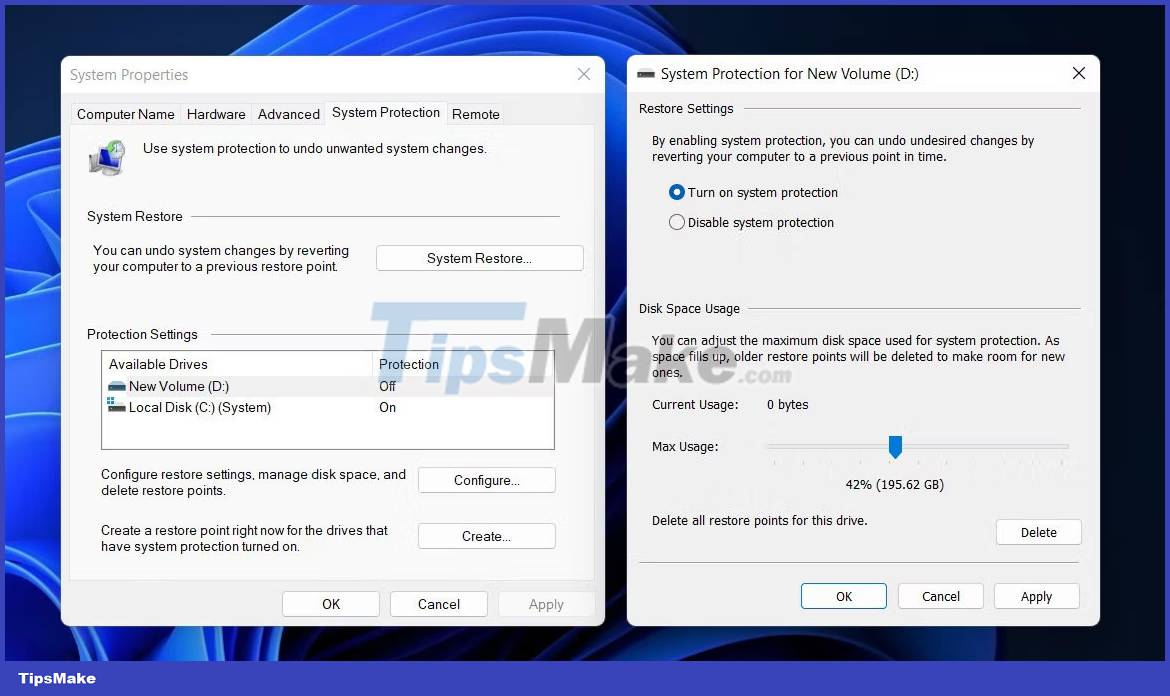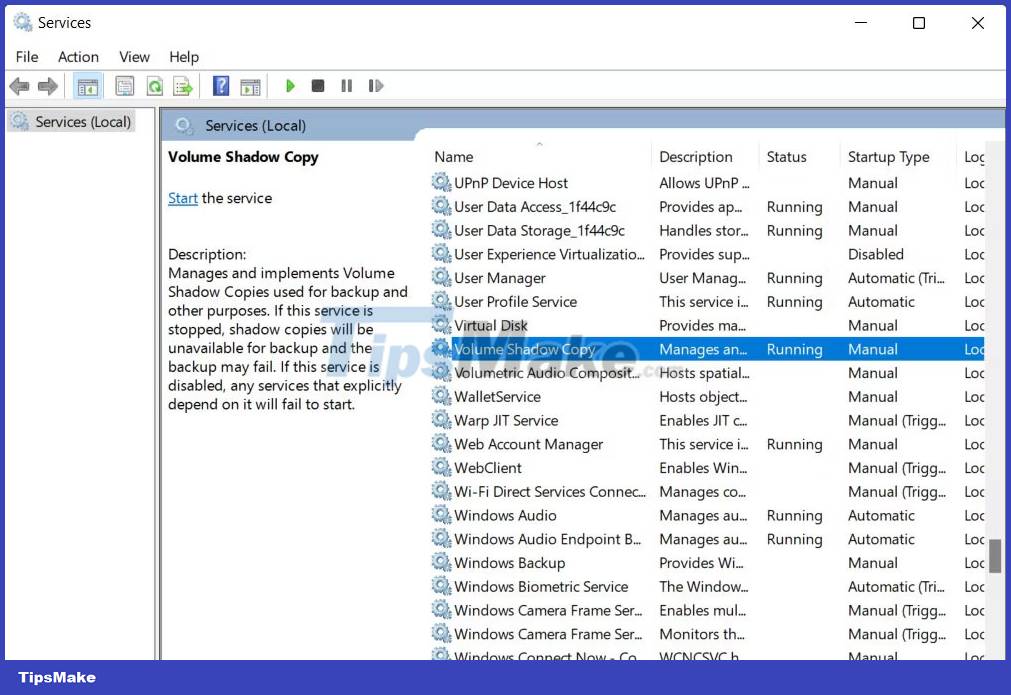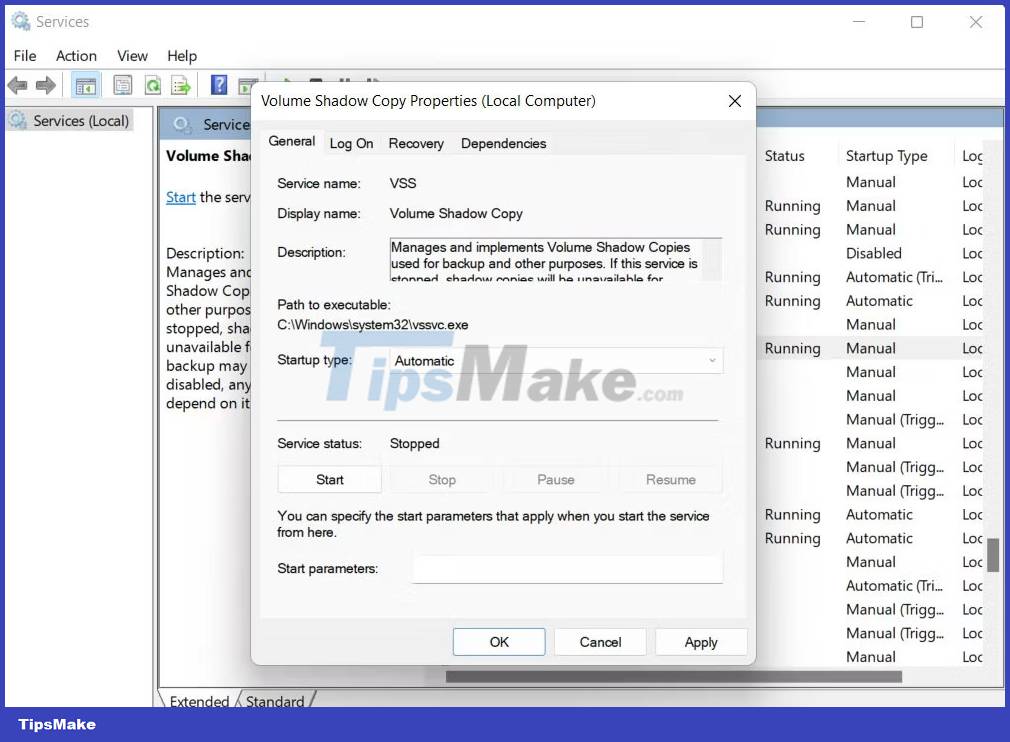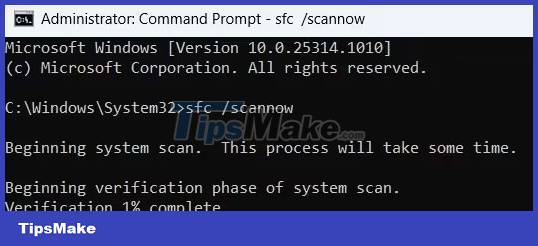How to fix System Restore error 0x80042306 in Windows
Error code 0x80042306 occurs when trying to create a restore point in Windows. It prevents the creation of new restore points in the system and usually occurs when the system does not have enough free space, there is a problem with the Volume Shadow Copy (VSS) service, or a background process conflicts with the recovery utility.
The following article will cover different troubleshooting methods that you can try to fix system recovery error 0x80042306 in Windows.
Note : You should boot into the admin account before continuing.
1. Make sure you have enough space
Restore points require free space on the drive on which they are stored. The amount of space this restore point requires usually depends on the size and complexity of the system configuration.
If you don't have enough space on the drive, the recovery utility may return error 0x80042306. This is why you should start by making sure that there is enough free space for System Restore to work properly. You can delete unnecessary items to increase space manually or use the Disk Cleanup utility provided by Microsoft by default.
Alternatively, you can also increase the disk space allocated to System Restore in the System Protection settings. Here's how you can do it:
1. Type "Create a restore point" in the Windows search utility and click Open.
2. In the following dialog, go to the System Protection tab .
3. Click the Configure button and use the Max usage slider to adjust the drive percentage to your preference.

4. Click Apply > OK to save the changes.
Once the changes are made, check if you can now create a restore point without any problems.
2. Restart the Volume Shadow Copy service
You may also experience problems if the Volume Shadow Copy service is disabled or simply not working properly.
This service allows to create backups of files and volumes in Windows. It is used by the restore utility to take snapshots of the items being backed up, and if it doesn't work for any reason, you may have problems.
To make sure this service works properly, you can restart the service using the Services utility. Follow the steps below to continue:
1. Press the Win + R key combination to open Run.
2. Type "services.msc" in Run and press Enter.
3. In the Services window , scroll down to find the Volume Shadow Copy service and right click on it.

4. Select Properties from the context menu.
5. Now click the Stop button , wait a few seconds and press Start .
6. Make sure the Startup type is set to Automatic .

7. Finally, click Apply > OK to save the changes.
Do the same with the Windows Backup service and check if the problem is resolved.
3. Re-register VSS . components
If restarting the Volume Shadow Copy service doesn't work, you can also try re-registering VSS components through the Command Prompt.
Here's how to proceed:
- Press the Win + R key combination to open Run.
- Type "cmd" in Run and press Ctrl + Shift + Enter to open CMD with admin rights.
- Click Yes in the User Account Control prompt.
- Now, execute the following commands one by one:
cd /d %windir%system32net stop vssnet stop swprvregsvr32 /s ole32.dllregsvr32 /s oleaut32.dllregsvr32 /s vss_ps.dllvssvc /registerregsvr32 /s /i swprv.dllregsvr32 /s /i eventcls.dllregsvr32 /s es.dllregsvr32 /s stdprov.dllregsvr32 /s vssui.dllregsvr32 /s msxml.dllregsvr32 /s msxml3.dllregsvr32 /s msxml4.dllvssvc /registernet start swprvnet start vss -
Once you have re-registered the VSS components, close CMD and try to create the restore point again.
If a problem in VSS components is causing the problem, restarting the components will fix the problem.
4. Create a restore point in Safe Mode
In some cases, conflicting background processes can also prevent the System Restore utility from creating a successful restore point. The best way to make sure there are no apps or programs running in the background interrupting System Restore's functionality is to try creating a restore point in Safe Mode.
This mode launches Windows with a minimal set of drivers and services, which can help isolate problems and prevent any possible conflicts in normal mode. Here's how you can boot into Safe Mode:
After entering Safe Mode, try creating a restore point again and check if the problem is resolved.
5. Scan your system for corruption

The System Restore utility itself may be experiencing corruption errors that prevent it from working properly. To repair any corrupted system files, you should use the System File Checker (SFC) and Deployment Image Servicing and Management (DISM) tools. SFC works by scanning protected system files for potential problems. If an issue is detected, it will replace the corrupted file with the error-free cached version.
DISM, on the other hand, works by repairing corrupted system images. TipsMake has a guide on how to use SFC and DISM in Windows that you can refer to for the right steps.
You should read it
- This is how to 'recover' a failed USB drive on Linux
- Instructions on how to fix 53 error when restoring on iPhone
- Instructions on how to use System Restore on Windows
- 6 ways to fix Bluetooth errors not in Device Manager on Windows 10, 8.1, 8, 7, XP, Vista
- Part II: Troubleshooting
- Steps to fix error 0x80070026 when Windows Update or Restore
- Error Camera icon on iPhone 7/7 Plus lost after iOS 10 update, this is how to fix the error
- How to fix A20 Error when starting the computer
May be interested
- Steps to fix error 0x80070026 when Windows Update or Restore
 how to fix error 0x80070026, this error usually appears when you update windows or restore windows. when error 0x80070026 appears, all tasks will fail and the action cannot be performed again.
how to fix error 0x80070026, this error usually appears when you update windows or restore windows. when error 0x80070026 appears, all tasks will fail and the action cannot be performed again. - How to Manage System Restore Points Using CCleaner (Windows)
 system restore is a wonderful feature that allows you to bypass software issues by restoring your computer without losing any important data. however, a new system restore point is created each time you clean your windows, which can not...
system restore is a wonderful feature that allows you to bypass software issues by restoring your computer without losing any important data. however, a new system restore point is created each time you clean your windows, which can not... - Restore previous Windows version from Windows 7
 this article will show you how to manually restore the previous windows operating system installation to replace the version of windows 7 operating system you are using by using the windows.old folder.
this article will show you how to manually restore the previous windows operating system installation to replace the version of windows 7 operating system you are using by using the windows.old folder. - Part II: Troubleshooting
 when you encounter a bsod error (blue screen of dead), you first need to consider which error group it belongs to in the previous section, but by default windows will automatically restart the system. system when an error occurs.
when you encounter a bsod error (blue screen of dead), you first need to consider which error group it belongs to in the previous section, but by default windows will automatically restart the system. system when an error occurs. - How to Fix Corrupted USB in Linux
 usually, users use usb drives to store data safely. however, in some cases, usb drives may be corrupted or simply not working. if you are using linux operating system and encounter the same error on your usb drive, then you can use the commands to restore the usb drive.
usually, users use usb drives to store data safely. however, in some cases, usb drives may be corrupted or simply not working. if you are using linux operating system and encounter the same error on your usb drive, then you can use the commands to restore the usb drive. - How to Do a System Restore
 this wikihow teaches you how to restore a previous version of your windows computer's operation. keep in mind that you will need to have a restore point on your computer in order to use system restore. if you want to restore a mac, you'll...
this wikihow teaches you how to restore a previous version of your windows computer's operation. keep in mind that you will need to have a restore point on your computer in order to use system restore. if you want to restore a mac, you'll... - How to fix 'An operating system not found' error on Windows 10 and Windows 8.1
 error an operating system was not found is one of the common ones that usually happens on windows 10 or windows 8.1. this error comes out after the user upgrades windows (from windows 8.1 to windows 10), updates the bios, .... if the screen of your windows 10 or windows 8.1 computer displays the message an operating system wasn ' t tìm thấy. hãy thử gỡ bỏ nào nào mà không chứa một hệ thống hành động. press ctrl + alt + del to restart, follow the steps below to fix the error.
error an operating system was not found is one of the common ones that usually happens on windows 10 or windows 8.1. this error comes out after the user upgrades windows (from windows 8.1 to windows 10), updates the bios, .... if the screen of your windows 10 or windows 8.1 computer displays the message an operating system wasn ' t tìm thấy. hãy thử gỡ bỏ nào nào mà không chứa một hệ thống hành động. press ctrl + alt + del to restart, follow the steps below to fix the error. - How to Use System Restore on Windows 7
 when you come across a problem on your computer and you cannot seem to fix the issue, using system restore is probably your best bet. the system restore function on windows 7 allows you to roll back your computer to a previous time before...
when you come across a problem on your computer and you cannot seem to fix the issue, using system restore is probably your best bet. the system restore function on windows 7 allows you to roll back your computer to a previous time before... - Complete how to use all backup and restore tools on Windows 10
 windows 10 has many built-in backup and recovery tools so that users can select, exploit and use for the purpose of protecting their data and systems safely. microsoft brought back the windows backup backup tool that has been 'removed' in windows 8.1, the file history function has also been preserved and some backup options on the cloud and other system restore in important cases .
windows 10 has many built-in backup and recovery tools so that users can select, exploit and use for the purpose of protecting their data and systems safely. microsoft brought back the windows backup backup tool that has been 'removed' in windows 8.1, the file history function has also been preserved and some backup options on the cloud and other system restore in important cases . - How to Restore Your Windows XP Computer
 a system restore can help fix problems that might be making your computer run slowly or stop responding. it will return your system to an earlier point in time. your computer automatically creates restore points that allow you to restore...
a system restore can help fix problems that might be making your computer run slowly or stop responding. it will return your system to an earlier point in time. your computer automatically creates restore points that allow you to restore...










 How to fix NVIDIA Control Panel 'Access Denied' error on Windows 11/10
How to fix NVIDIA Control Panel 'Access Denied' error on Windows 11/10 How to fix Microsoft .NET Framework 4 installation error 0x800c0006 on Windows
How to fix Microsoft .NET Framework 4 installation error 0x800c0006 on Windows 3 ways to reset Folder View Settings to default in Windows 11
3 ways to reset Folder View Settings to default in Windows 11 How to add weather information to the lock screen on Windows 10 and 11
How to add weather information to the lock screen on Windows 10 and 11 How to fix 'Windows could not start the WLAN AutoConfig' error
How to fix 'Windows could not start the WLAN AutoConfig' error 10 ways to open Display Settings in Windows 11
10 ways to open Display Settings in Windows 11